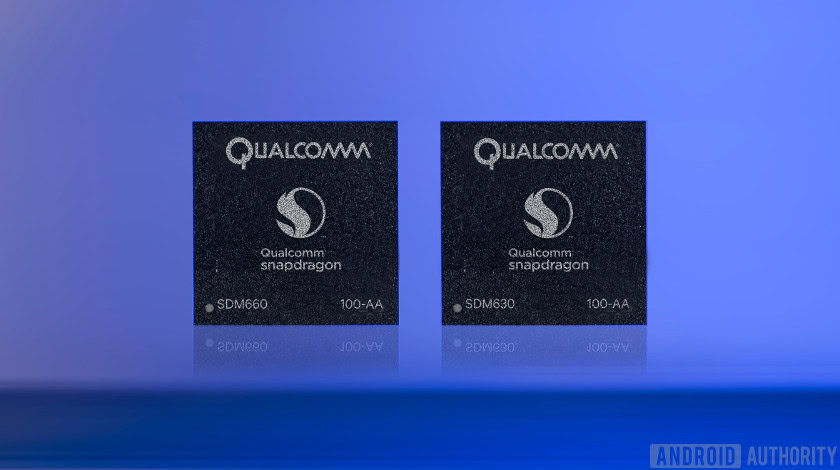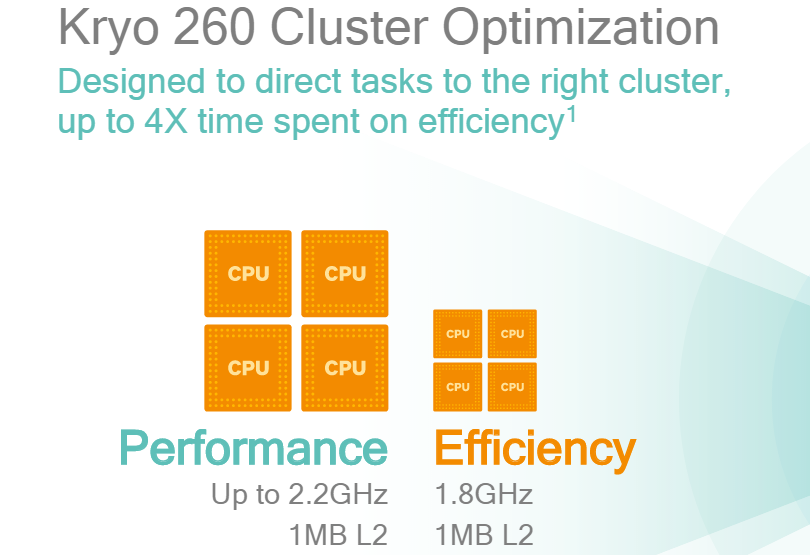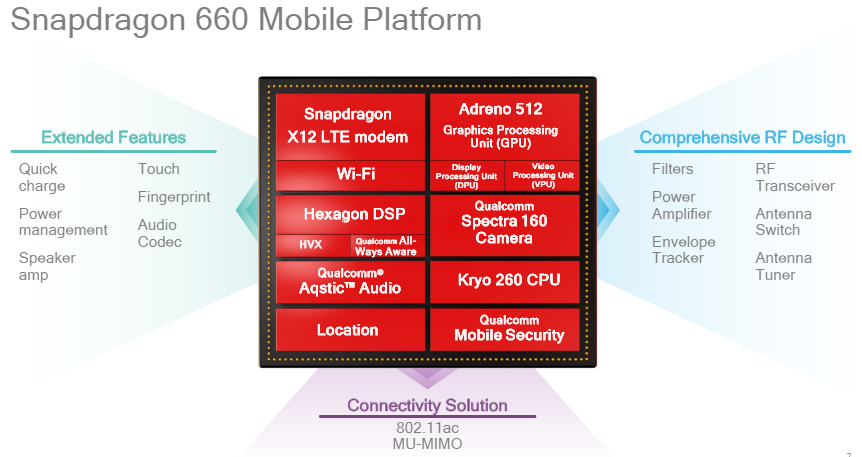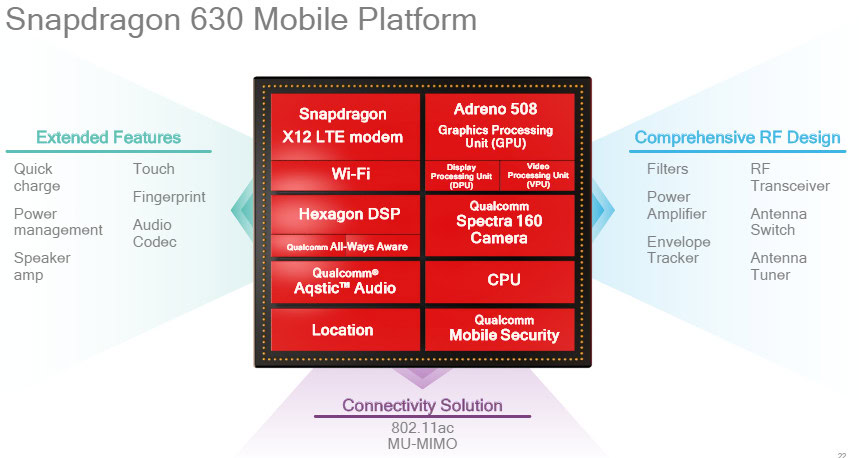Affiliate links on Android Authority may earn us a commission. Learn more.
Qualcomm Snapdragon 660 and Snapdragon 630 unveiled
Published onMay 8, 2017

Today, Qualcomm has announced two new mobile platforms for the smartphone market – the Snapdragon 660 and Snapdragon 630. Sitting just under the company’s flagship 800 series, these two new processors are aimed at bringing flagship-tier performance and features to mid-range handsets.
For a quick glance at the specifications of Qualcomm’s latest and previous 600 series processors, check out the table below.
| Snapdragon 660 | Snapdragon 653 | Snapdragon 630 | Snapdragon 626 | |
|---|---|---|---|---|
CPU | Snapdragon 660 4x Kryo 260 @ 2.2GHz 4x Kryo 260 @ 1.8GHz | Snapdragon 653 4x Cortex-A72 @ 1.95GHz 4x Cortex-A53 @ 1.44GHz | Snapdragon 630 4x Cortex-A53 @ 2.2GHz 4x Cortex-A53 @ 1.8GHz | Snapdragon 626 4x Cortex-A53 @ 2.2GHz 4x Cortex-A53 @ 1.8GHz |
GPU | Snapdragon 660 Adreno 512 (Vulkan API) | Snapdragon 653 Adreno 510 | Snapdragon 630 Adreno 508 (Vulkan API) | Snapdragon 626 Adreno 506 |
Co-processors | Snapdragon 660 Hexagon 642 + HVX, All-Ways Aware, Spectra 160 | Snapdragon 653 Hexagon, All-Ways Aware, 2x ISP | Snapdragon 630 Hexagon, All-Ways Aware, Spectra 160 | Snapdragon 626 Hexagon, All-Ways Aware, 2x ISP |
LTE | Snapdragon 660 X12 LTE 600Mbps down, 150 Mbps up, 3x20MHz CA, up to 256-QAM | Snapdragon 653 X9 LTE 300Mbps down, 150Mbps up, 2x20MHz CA, up to 64-QAM | Snapdragon 630 X12 LTE 600Mbps down, 150 Mbps up, 3x20MHz CA, up to 256-QAM | Snapdragon 626 X9 LTE 300Mbps down, 150Mbps up, 2x20MHz CA, up to 64-QAM |
Bluetooth | Snapdragon 660 5 | Snapdragon 653 4.1 | Snapdragon 630 5 | Snapdragon 626 4.2 |
Quick Charge | Snapdragon 660 4.0 | Snapdragon 653 3.0 | Snapdragon 630 4.0 | Snapdragon 626 3.0 |
Process | Snapdragon 660 14 nm | Snapdragon 653 28nm | Snapdragon 630 14 nm | Snapdragon 626 14 nm |
Snapdragon 660
Starting with the Snapdragon 660, this mobile platform is the successor to Qualcomm’s existing 653 model. There are a couple of notable changes between these chipsets, the first of which is the move from a 28nm process down to a much more efficient 14nm node. Secondly, Qualcomm has introduced its Kryo 260 cores in its latest processor, switching things up for the octa-core ARM Cortex-A72 and A53 big.LITTLE combination seen in its predecessor.
Qualcomm hasn’t spilled the beans on exactly what makes up its Kryo 260 core, but it’s my suspicion that we’re looking at a similar Built on ARM Cortex Technology license that the company used for the Kryo 280, with some inhouse tweaks and a custom silicon layout. What we do know is that Kryo 260 comes in a familiar 4+4 octa-core arrangement, featuring four larger cores clocked at 2.2GHz with 1MB of L2 cache, while the little cores have their own 1MB L2 cache and are clocked at 1.8GHz.

On the GPU side, the Snapdragon 660 has been upgraded with a more powerful Adreno 512, up from the Adreno 510 seen inside the 653 model. Qualcomm states that these changes produce a 20-percent boost to CPU performance and 30-percent gains to GPU workloads.
Of course, Qualcomm’s latest mobile platform wouldn’t be complete without a suite of extra features. Inside the Snapdragon 660 we find an improved X12 LTE modem, Quick Charge 4 compliance, Bluetooth 5, USB Type-C with 3.1 speed compatibility, an improved Spectra 160 ISP with EIS 3.0, 2×2 WiFi, and the company’s Hexagon 642 DSP unit with All-Ways Aware technology and HVX.

For consumers, this means improved support for dual camera hardware and enhanced image processing capabilities, such as optical zoom and Clear Sight sensor arrangements, eye tracking, and depth mapping. This is all tied in with Qualcomm increasing focus on heterogeneous compute and machine learning capabilities, which is designed to make use of the most efficient processing components to complete any given task. Battery life has also received some extra attention, with Qualcomm suggesting that the 660 should grant users can extra 2 hours of battery life when compared to the 653.
“With the introduction of the Snapdragon 660 and 630 Mobile Platforms, we are thrilled that features such as improved image quality and fast LTE speeds will now be available in a wide array of devices without sacrificing performance or quality,” - Kedar Kondap, vice president, product management, Qualcomm
Snapdragon 630
The Qualcomm Snapdragon 630 is not quite as feature rich as the 660, but still offers up a number of improvements over its predecessor, the Snapdragon 625. This chip is also built on a 14nm process and is pin, modem, and ISP compatible with the 660, for those looking to conveniently adjust products for a slightly lower performance point.
The Snapdragon 630 sticks with the same octa-core ARM Cortex-A53 configuration as before, but with a slightly higher 2.2GHz peak clock speed for a 10 percent boost to performance over the 625. However, Qualcomm already announced a 14nm 2.2GHz Snapdragon 626 chip, so performance probably won’t be too different to what we’ve seen from this range in the past.

The 630 platform does feature a more powerful GPU though, having seen a leap from the Adreno 506 to the 508. Qualcomm states that this move offers up to a 30-percent performance improvement. The Snapdragon 630 also moves over to faster 2×16 LPDDR4X memory with a maximum clock speed of 1333MHz, which will be a boon to memory bound applications, including gaming.
Other improvements to the 630 mobile platform include the move on up to a X12 LTE modem, Spectra 160 ISP, support for QXGA (2048 x 1536) displays, Quick Charge 4, USB Type-C with 3.1 speeds, Bluetooth 5, All-Ways Aware support, and a Hexagon DSP but without the HVX extensions. Even so, both of Qualcomm’s new platforms can be used with machine learning algorithms through the Snapdragon Neural Processing Engine SDK, which offers support for Caffe/Caffe2 and TensorFlow.
